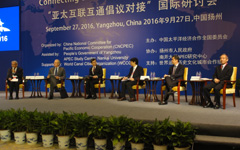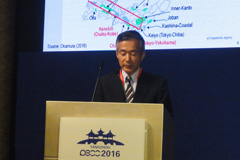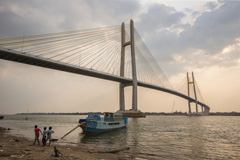JICA-RI Director Kitano Gives Presentation on Japan's Development Experience at International Symposium on Connectivity
2016.10.25
JICA Research Institute (JICA-RI) Director Naohiro Kitano spoke in Yangzhou, China, on Sept. 27 at an International Symposium on “Connecting the Connectivities in Asia Pacific” held by China National Committee for Pacific Economic Cooperation (CNCPEC), a Chinese agency of the Pacific Economic Cooperation Council (PECC). Kitano gave presentations on the lessons of the "Pacific Ocean Belt Zone" initiative, which was a development plan to increase connectivity within Japan during the 1960s, and on Japan's economic cooperation, which is rooted in its own experiences.
With regard to connectivity in the Asia Pacific region, the APEC Connectivity Framework was announced at the APEC Ministers Meeting held in 2013 in Bali, Indonesia. In order to "achieve a seamless and comprehensively connected and integrated Asia-Pacific" by 2025, the "APEC Connectivity Blueprint" was adopted at the APEC Economic Leaders’ Meeting in Beijing in 2014 and reconfirmed at the leaders’ meeting in Manila, the Philippines, in 2015. As many regional organizations and economies have taken their own connectivity-related initiatives, this symposium was held to explore the pathways to connect various connectivity initiatives within the region.

Participants engaged in discussion
Kitano spoke at the first session, entitled "The inner links between the regional and sub-regional connectivity initiatives and the opportunities and challenges for connecting these initiatives," about Japan's experience of connectivity-oriented development.
Taking the Pacific Ocean Belt Zone as an example, Kitano brought up three lessons from Japan's experience: First, the Pacific Ocean Belt Zone as an organic combination of major industrial zones is effective in helping to promote industrial agglomerations through private investment, which leads to economic growth. Second, we must pay attention to the need to minimize regional disparities in order to achieve balanced growth. And third, serious negative effects such as environmental deterioration and pollution were seen as the result of the rapid industrialization in Japan's metropolitan areas. We must address these negative side effects.

JICA-RI Director Naohiro Kitano
In his presentation on Japanese economic cooperation based on its experiences, Kitano talked about the cases of the development of Shanghai and the development of Thailand's Eastern Seaboard. He also introduced the Japanese economic cooperation model as the approach of encouraging economic growth through linkages between aid, direct investment and trade. In concrete terms, this means various infrastructure built with Japanese aid contributes to increase investment and trade, to encourage industrial agglomeration, and to make rapid economic transformations possible. He also explained that based on its experience of achieving regionally balanced development, Japan emphasizes the importance of balanced growth.
Finally, Kitano talked about JICA's assistance to strengthen ASEAN connectivity. He talked about the Neak Loeung Bridge (Tsubasa Bridge) in Cambodia as an example of quality infrastructure, one of the Japanese developmental assistance projects to improve physical connectivity in the East-West and Southern Mekong Economic Corridor based on the Master Plan on ASEAN Connectivity. On the topic of institutional connectivity, he talked about Japan's assistance with improving various countries' customs and trade systems based on the concept of an "Asia Cargo Highway," which aims for the seamless flow of goods and services. Also, as an example of strengthening people-to-people connectivity, he talked about AUN/SEED-Net (ASEAN University Network/Southeast Asia Engineering Education Development Network), which has been carried out with the objective of continuously turning out large numbers of engineers by strengthening the educational and research capacity of universities in ASEAN countries and by strengthening networks between universities in various countries including Japan.

Tsubasa Bridge in Cambodia connects Vietnam, Cambodia and Thailand with a single road (Photo: JICA/Shinichi Kuno)

事業事前評価表(地球規模課題対応国際科学技術協力(SATREPS)).国際協力機構 地球環境部 . 防災第一チーム. 1.案件名.国 名: フィリピン共和国.

事業事前評価表(地球規模課題対応国際科学技術協力(SATREPS)).国際協力機構 地球環境部 . 防災第一チーム. 1.案件名.国 名: フィリピン共和国.

事業事前評価表(地球規模課題対応国際科学技術協力(SATREPS)).国際協力機構 地球環境部 . 防災第一チーム. 1.案件名.国 名: フィリピン共和国.

事業事前評価表(地球規模課題対応国際科学技術協力(SATREPS)).国際協力機構 地球環境部 . 防災第一チーム. 1.案件名.国 名: フィリピン共和国.

事業事前評価表(地球規模課題対応国際科学技術協力(SATREPS)).国際協力機構 地球環境部 . 防災第一チーム. 1.案件名.国 名: フィリピン共和国.
scroll